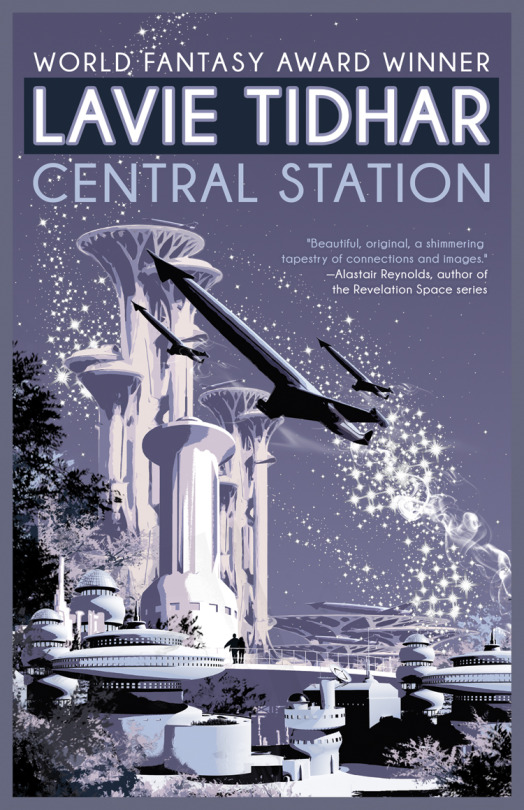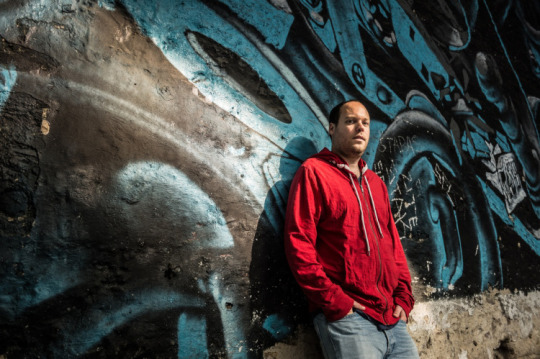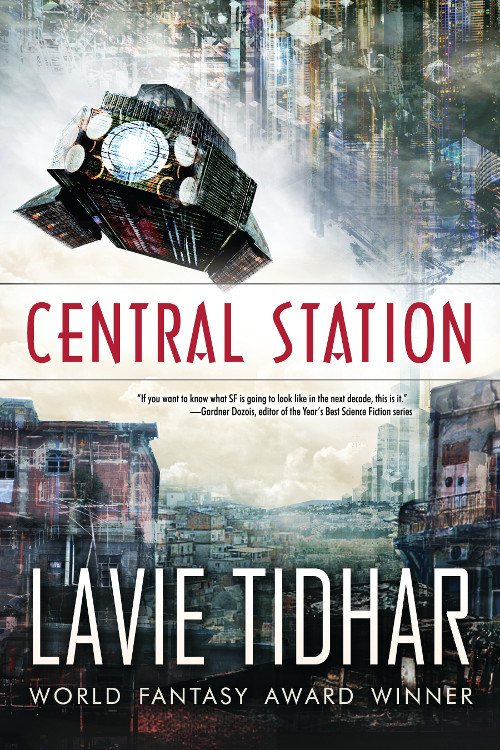CENTRAL STATION seems both thoroughly new and oddly familiar
The reviews keep flooding in for Lavie Tidhar’s fantastic and refreshing CENTRAL STATION.

For the CHICAGO TRIBUNE, Gary K. Wolfe praises Lavie Tidhar’s CENTRAL STATION.
Lavie Tidhar, who was raised in an Israeli kibbutz and has lived in places as exotic as Vanuatu, has for several years been writing sharply insightful stories set around the Central Station district of Tel Aviv, which in his future has become a massive, bustling spaceport and home to a stew of colorful figures and subcultures. By weaving and reshaping these tales into a sort of novel, he has created a textured and original future that echoes real historical and economic tensions while satisfying veteran readers with deliberate echoes of classic science fiction.
<snip>
In the world of Central Station, nearly everyone is connected to the web (or Conversation) by an internal node, though a few holdouts still prefer ancient forms of information like books. Hallucinatory drugs remain a popular pastime and addiction, as do online games where characters can make a decent real-world living. Death can be sidestepped by cryogenics, by becoming a cyborg, or by simply uploading into the Conversation — where a separate, non-human society of artificial intelligences already thrives. Wounded cyborg veterans called robotniks remind us that war has not been eliminated. This world unfolds through the linked adventures of a series of characters including a “data vampire” (named after a character in a classic C.L. Moore story), a boy hoping for his father to return from space, the owner of a popular bar and her old-fashioned book collector brother, a legendary junk dealer, and a famous artist. Despite the book’s affectionate allusions to earlier science-fiction themes, its deeply humane world seems both thoroughly new and oddly familiar.
Both IO9 (”We’ve really loved some of his earlier novels, and we’re looking forward to this one.”) and BOOKS, BONES & BUFFY (”This sounds like all kinds of awesome!”) look forward to the book.

Lavie Tidhar tries to remain cool among all the accolades (Photo: Kevin Nixon. © Future Publishing 2013.)
Sam Lubell at SFREVU reviews the “something different” CENTRAL STATION.
CENTRAL STATION is a wonderful piece of worldbuilding. The book takes place in a future Israel, where some Jews have Asian names and robots can conduct Jewish rituals. Nearly all the characters are linked in the Conversation, essentially an internally accessed wireless Internet/virtual world. Data vampires called Shambleaus can feed off of humans’ connections to the Conversation. Other humans have Martian symbionts. There are the few remaining robots and robotniks–discarded cyborg soldiers reduced to begging or odd jobs. There are mentions of mysterious Others, never really defined. People have jobs in the virtual world they can convert into rent money. And a few children with hacked genes from a Messiah breeding program have special powers.
<snip>
This book is perfect for literary readers who want something different, who enjoy images and language more than plot and action. This is a book that needs close attention and a re-read for a more complete understanding. It’s not a light beach read or for multi-tasking while watching television. CENTRAL STATION is not like anything else you’ve read. This book shows clearly that Lavie Tidhar is an author to watch.

KOENIX loved their introduction to the works of Lavie Tidhar.
Central Station is a “fix-up” novel of previously published short stories by Lavie Tidhar — stories which were always intended to be drawn together into a whole novel. It hints at huge changes and shifts for humanity while intimately focusing on the individuals; it’s about a transformed human experience in the solar system, but stays in a single city. And it harks back to the feel of a golden age of SF with a distinctly retro vibe that is rich and imaginative. It manages to evoke the past and the future simultaneously, making me feel a sense of longing and familiarity with a history of pulp SF I’ve not even read! (And just look at that cover art from Tachyon — it’s perfect!)
This is the first work I’ve read by Lavie Tidhar, and I can’t wait to read more. I was so happy to come to Central Station without any expectations, encouraged by only a few brief anticipatory remarks from others. I not only thoroughly enjoyed Central Station, I also enjoyed going in blind and letting its atmosphere sink in.
<snip>
The lushness, the alien-ness, but organic feel of the setting of Tel Aviv, with the gamespace and the Conversation flickering in and around, reminded me of HYPERION by Dan Simmons. The idea that this is on Earth but felt actually alien to me was fantastic and refreshing: this is a futuristic imagining of a part of the world that is already unknown to me, but remained human and real.
The truth is I loved reading this book so much but it’s hard to explain why, because it was so personal. It triggered some wonderful memories of other books and reading experiences and this intangible thing I seem to be pursuing in my own personal reading journey. Is it possible to feel nostalgia for a book while reading it for the first time? Because that’s what it felt like. I also appreciated the subtle nature of the story itself: there may not be a decisive-enough conclusion to the tale for some readers, but I didn’t need one. There are hints and implications and I saw where the story could go… it was the journey itself and the characters that I devoured.
STRANGE ALLIANCES joins the fun with a review of their own.
The readers’ entry into the world of CENTRAL STATION begins as a ‘I am a camera’ type of tour, highlighting both the exotic and grimy mundane of the many inhabitants populating this dense gathering of people, until there is a smooth and seamless zoom in to Mama Jones and her otherworldly adopted son Kranki and the conversation they are having. This constant shift of focus back and forth between the surroundings and the different characters demonstrates Lavie Tidhar’s skill at world building and making you feel you should have a vested interest in the outcome of the people within in it.
<snip>
So strange and yet so much of this story could be dropped into our world because this is about relationships and connectedness; about different people with different beliefs living side by side as in a community, albeit uncomfortably at times. This is science fiction told on an intimate scale. Because of this, the strangeness disappears into the background, although its presence is responsible for the way Tidhar is able to make the reader really think about the everyday issues we might encounter and are effectively being discussed by the story.
That CENTRAL STATION was developed from short stories is an interesting proposition for any writers reading this novel, because it demonstrates that it is possible to play with ideas, put them out there and continue to develop them into something that has coherence. Certainly there is a sense of episodes as the narrative is explored through different viewpoints, but this provides helpful bookmarks, because at less than 300 pages this is a novel dense with concepts and characterisations.
This is the type of story that has a unique footprint and because of that will need an audience tuned to Tidhar’s excursions into his more unusual styles of writing. But it is worth an outing for those not familiar with him and anyone wanting to understand how to write the type of science fiction that really has something to say without making an extravagant opera out of it. For those who do enjoy Tidhar’s work this is definitely a novel that will stand more than one reading because of the richness of the narrative and the ideas that are developed within it.
For more info about CENTRAL STATION, visit the Tachyon page.
Cover and poster by Sarah Anne Langton



